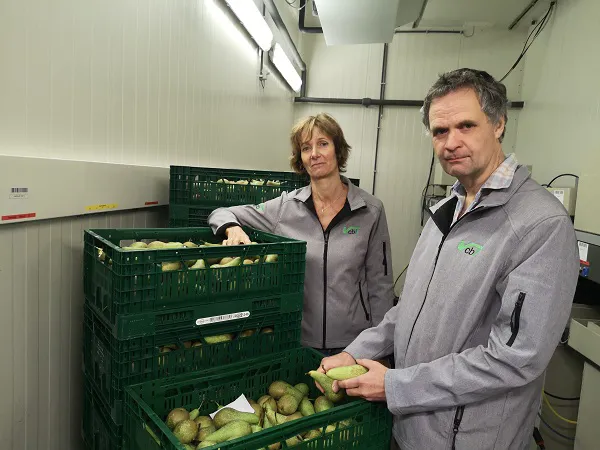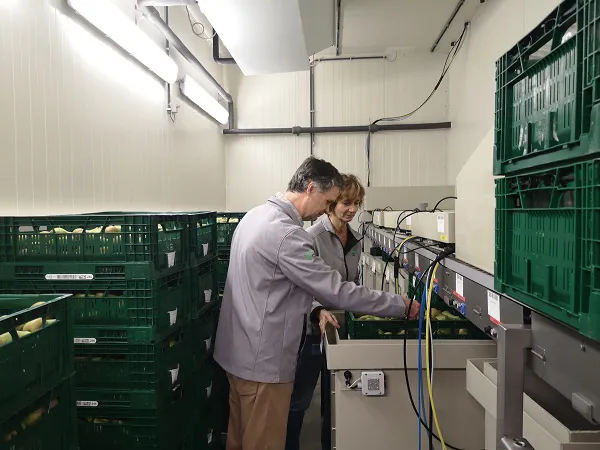"Energy costs are making up a bigger part of production costs everywhere," is how Ann Schenk of the Flemish Center for Storage and Horticultural products (VCBT) summarizes the situation surrounding rising top fruit refrigerated storage costs. The VCBT is a Belgian Horticultural Cooperatives Association (VBT) and Leuven University collaboration that researches and develops post-harvest technology.

Ann Schenk and Bert Verlinden of VCTB
That is resulting in increased requests for advice from the VCBT, says Ann and her colleague Bert Verlinden. Belgian top fruit harvesting was in full swing in late August, so that subject appears to be more topical than ever. For now, Ann and Bert do not think the high costs will lead to growers abandoning top fruit storage or selling more off the trees. "There's currently no market for that, so growers are left with little choice," Ann begins.
Using less energy would be a logical response to curb rising refrigeration costs. Not a good idea, says the VCBT. "If you start cutting back on refrigeration, it immediately negatively affects fruit quality," Bert points out. Shorter storage time may, however, be an option. "But, of course, you must be able to market the fruit. If it all comes on the market at once, prices collapse, so shorter storage is only possible to a limited extent." However, growers must know which batches can be stored to avoid unnecessary costs. They must not find, at the end of the storage process, that the fruit's quality is lacking.
Prediction models
The VCBT has thus developed prediction models using specific parameters to see if you can store an apple or pear batch. The model is based on things like the fruits' starch content and firmness. Bert notes that some of these batches are clearly more suitable for storage than others. "We take some non-damaging measurements right after harvesting and use those to make a prediction. We can tell which batches are more or less eligible for long storage. Because if you store low-quality fruit that comes out of the fridge badly, you've paid twice; you can't sell the fruit, AND you incur costs. You should definitely avoid that," he says.
"And if you do decide to refrigerate, it's vital for the fruit's long-term quality to do so directly after harvesting. You shouldn't delay to save power," adds Ann. Although it is the biggest cost, she says you cannot skimp on refrigeration. "Getting rid of the field heat is the biggest expense, but if you're going to refrigerate, you have to do it right. You have to make a choice. Isn't it better to say, chill only half, well, and market the other half right away than refrigerate the whole batch badly?"

Reducing respiration
Still, there is something you can do to cut back on energy costs when it comes to chilling top fruit. For example, you can use ethylene as a post-harvest treatment. Ann explains that this inhibits pear and apple ripening, reducing the fruits' respiratory activity by 30 to 40%.
"Along with respiration, heat production declines, cutting back on the need for refrigeration." Plus, ethylene inhibitors reduce CO2 production. When apples and pears are stored for a long period, CO2 is removed mechanically from Ultra Low Oxygen (ULO) cold rooms. "So, when using an ethylene inhibitor, you need less power because you have to remove less CO2," she explains.
Another development that impacts energy use is Dynamic Controlled Atmosphere (DCA). Here, storing the fruit at low oxygen levels also inhibits their respiratory activity. With DCA, unlike ULO, the minimum oxygen content the fruit can tolerate is determined per batch.
"A good batch may well be able to tolerate much lower oxygen than in a regular ULO cell," Ann says. She cites Jonagold as an example. In a standard ULO cold room, these are kept at one percent oxygen, but in a DCA cold room, depending on quality, that could be as low as 0.5 or even 0.3%. "There's far less respiration and thus less heat production, and you need less refrigeration."
Tricky topic
The Dutch fruit company Masteling cultivates and chills top fruit and says refrigeration is a hot yet tricky topic in the top fruit sector. Cees Masteling notes that cooling costs differ vastly because the starting points can vary substantially. "It's a difficult subject. Some companies still have €0.05 power contracts, while others are paying €0.20. That creates uncertainty and inequality in the market, which leads to discussions about selling prices."
These vast differences mean each situation must be considered individually, he says. Cees' electricity contract expires in December. "After that, we'll have to pay more too. We don't pass that increase on because the market dictates sales, and we have regular customers we must serve," he explains. He points out, though, that they're trying to factor the increasing costs into the price, but that is not easy.
No increased off-tree sales, but empty cold stores
According to Cess, there is no increased interest in off-tree sales, which is not an obvious choice regarding apples and pears. "Those kinds of sales are hard because the harvest in Europe is quite large. The trade, thus, assumes there will be enough fruit available later in the season and so doesn't want to buy top fruit now."
Clearly, the increasing refrigeration costs will have consequences. Cees does not think it will significantly affect top fruit's total volume. Nonetheless, there are some empty cold stores. "If refrigeration costs more than it brings in, you have some careful thinking to do," he concludes.
Ann Schenk
[email protected]  Bert Verlinden
Bert Verlinden
[email protected]
VCTB
www.vctb.be
Fruitbedrijf Masteling
T: +31 (0)527 201 471
[email protected]
www.fruitbedrijfmasteling.nl
